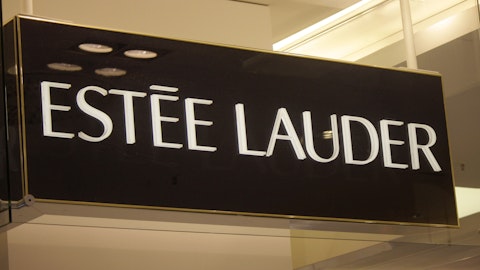That’s the first big pressure point that we address. The second was the China growth and the China focus in the long term. I believe I addressed this in my previous answer. The third one is accelerating our plan to stabilize market share in the U.S., and we are addressing this, first of all, attacking very clearly our opportunity in active derm with the Clinique heritage position and with The Ordinary’s extraordinary success. We will continue to address our distribution mix improvement needs toward the consumer growth segment and the channel segment. We are accelerating our fragrance sales growth, which is very important in the region, and also would like to remind that we have the top two brands in skin care and in makeup in the region, and in skin care with the arrival and the growth of The Ordinary, now we have four of the top five skincare brands in the market and The Ordinary gained 200 points of share in the prestige market just in quarter two.
We are addressing very decisively the future opportunities of this in North America. So a second point is we want to continue building on our strengths, and we said that we have strengths clearly in APAC ex-China at this moment with the comeback of Hong Kong, with a very important improvement versus the COVID period. In EMEA, we continue to have strong growth, for example in skincare and in markets in Germany, Italy, Spain, Turkey. Our emerging markets grew mid-double digits, and we believe we have a strong opportunity in emerging markets, where we have very strong market share position in every one of the top ones for the future acceleration. Our direct-to-consumer business, our freestanding stores grew double digits, supporting also our brand strength in equity, so we will continue building on all these strengths and our plans focus on this.
We remain confident in the future of the prestige beauty market, so there remains very attractive–we remain focused as a pure player on these very high growth [indiscernible] market in the consumer goods industry, and finally, as I said, the profit recovery plan and the restructuring will be a key enabler of all these strategies in our future. So yes, we see that we are at an inflection point and that we are going to measure ourselves on all these elements combined, meaning we are going to measure ourselves with the pace of recovery of our profitability, with going back to a growth–sustainable growth model and investing in our brands for the future, and re-addressing the needed changes in our organization to improve agility of resource allocation and speed to market.
Operator: The next question comes from Olivia Tong with Raymond James. Please go ahead.
Olivia Tong: Great, thanks. I wanted to talk a little about, just first, a follow-up on your U.S. distribution comments in terms of stabilizing U.S. share. With Clinique and The Ordinary sort of towards the entry level price point in prestige, how do you think about further diversification in U.S. distribution, especially as department store exposure continues to come down? Thanks.
Fabrizio Freda: As you know, we are working on this for some time, and the way we address it is that we are going to continue to increase the focus on high growth channels. We have done some extraordinary improvement in the specialty channel in the last year, and that will continue to be our focus. We are also obviously focusing our support to our department store partners where we have high market share, and we are managing this business carefully, and we are continuing to accelerate online with various opportunities that we have in this world, and the consumer is shopping more and more omnichannel, and so we are going to continue to put focus on the opportunity of omnichannel growth that we have in the United States. That’s what we are doing, and you will see this strategy to be implemented step by step in the next 12 months, accordingly, to these opportunities.
Operator: The next question comes from Oliver Chen with TD Cowen. Please go ahead.
Oliver Chen: Hi Fabrizio and Tracey. You mentioned agility many times. What are your thoughts on the priorities in terms of what you’ll do there, as well as direct-to-consumer and digital? Community engagement, as you know, is very important in terms of user-generated content and making sure to embrace a lot of new formats. A follow-up – as we model inventory in the back half, your inventories are in much better shape, but what gives you the conviction that the inventory levels related to Asia travel retail will be healthy in terms of the back half? Just some key aspects and being more confident there. Thanks a lot.
Tracey Travis: Thanks Oliver. I’ll start with the inventory levels. You know, we’ve made significant progress, as we said in our prepared remarks, on inventory and bringing down the levels of inventory in the trade that were high in pockets of Asia travel retail. We are pretty comfortable that we will be able to bring those down to levels that are healthier, that are expected to drive regular replenishment levels and therefore be the net sales accelerator that we have embedded in our guidance for the second half of the year. In addition, what we spoke about is we’ve also, at the same time of bringing down inventory levels in the trade, brought inventory levels down in-house, and that is part of the benefit that we saw in terms of the cash improvement in the quarter, and we expect with the tools that we’ve invested in and having healthier levels of inventory overall, largely driven by the pull down in production that we did in the first quarter that we spoke about, that we are going to be in much better shape as we support some of the upcoming innovation that we have, as well as in the future in terms of bringing inventory levels into better control.
Obviously the investment that we’ve done, as Fabrizio mentioned, in our Asia supply chain allows us to have shorter lead times in the region and be able to better manage any volatility that may occur in the future, now that we have a plant and an R&D center in the region, so all of those things help us in terms of creating better inventory agility, being able to produce faster to market demand than we have been in the past.
Fabrizio Freda: Then your question in agility, there are two measures of agility that we look at as very important. One is agility in responding to volatility faster in reallocating resources, so the action in this area has been the shortening of our supply chain in Asia, for example, and the various aspects–even the way we are repositioned. We are leveraging the historical heritage position of Clinique and doubling down on it in active derma, the way we are leveraging The Ordinary strength in active derma, so in other words how we are responding to the consumer trend of active derma now very decisively, so those are elements of agility. We want to improve our ability to do these things faster and more promptly in the future.
The other aspect of the agility is the way we go to market, so reaction to, for example, the new platforms. We are learning how to operate with Tiktok globally; much more, we are focusing on earned media value much more our organization, including resource allocation but also the training and the development and the understanding of the various models. We are doing this is all markets for the world at the same time. We are modernizing our promotional models and making them more relevant to the current consumer trends, and importantly as an umbrella concept, we are becoming more and more able to react to trends. There are two kinds of trends we are working our organizational development on. The first is the long term trends, the fundamental changes in consumer preferences, where frankly we have been always pretty strong, and we are further refining these abilities.
Then there are the short term trends, the trends that can change in a week, in a month of what’s going to be popular online in a certain country, in a certain moment, where we have developed better and better models to react to short term trends with our brands, with our execution, with our resource allocation. And by the way, the work on organization of the profit recovery plan is also pillared to improve our ability in both these areas, meaning the agility in resource allocation and the agility in reacting to trends and to the new models of marketing around the world.
Operator: The next question comes from Dana Telsey with Telsey Advisory Group. Please go ahead.




